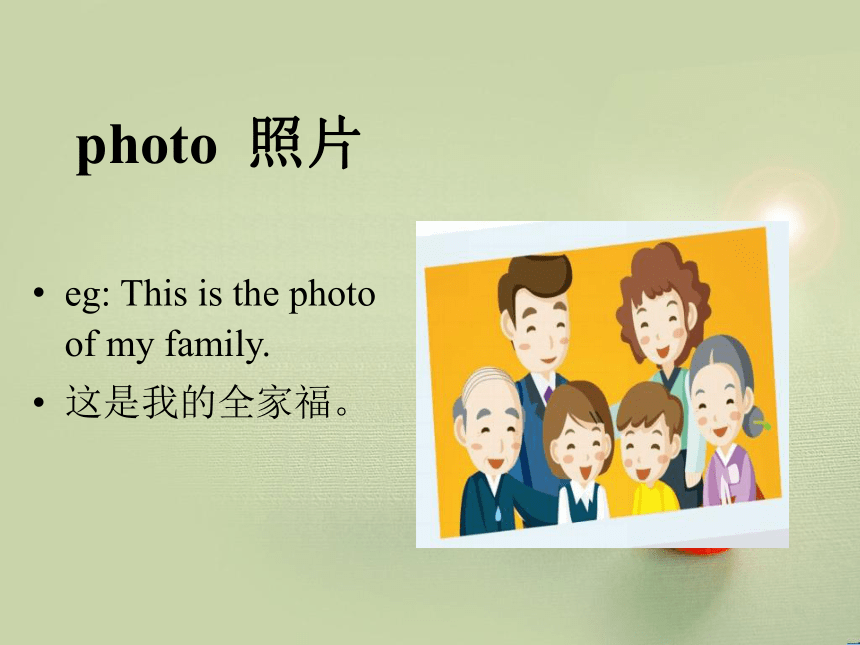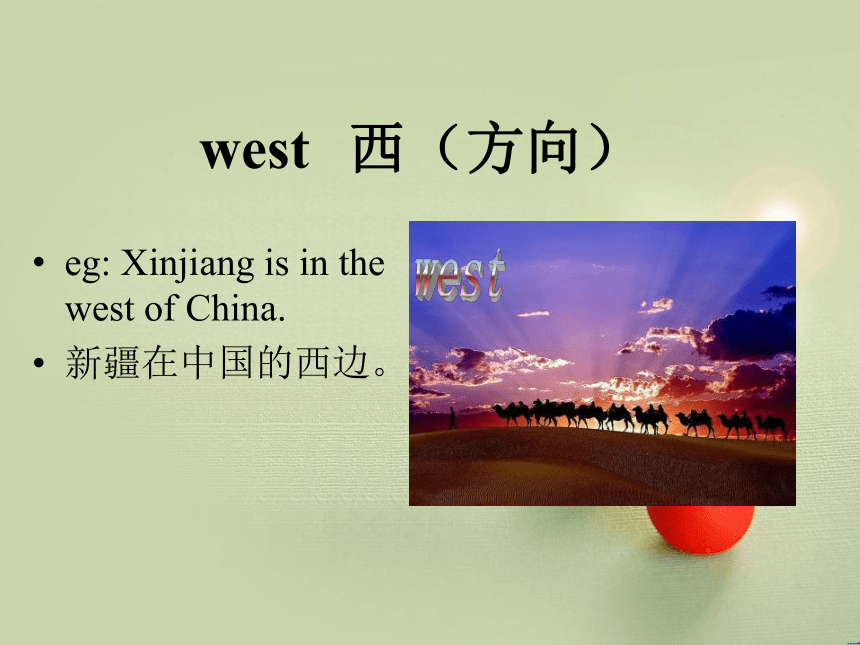Unit 1 I went there last year 课件(42张PPT)
文档属性
| 名称 | Unit 1 I went there last year 课件(42张PPT) |  | |
| 格式 | zip | ||
| 文件大小 | 3.4MB | ||
| 资源类型 | 教案 | ||
| 版本资源 | 外研版(三年级起点) | ||
| 科目 | 英语 | ||
| 更新时间 | 2019-03-27 14:25:10 | ||
图片预览












文档简介
课件42张PPT。Unit 1
I went there last year.moon 月亮,月球eg: Look at the beautiful moon in the sky!
看天空中那轮美丽的月亮!
moon单词get 到达eg: We get to school at about 7:30 every day.
我们每天大约七点半到校。
getget, arrive与reachparent 母亲;父亲;家长 eg: They are my parent.
他们是我父母。
parentholidayholiday 假期eg: I went to Beijing for my holiday.
我假期去了北京。
photosphoto 照片eg: This is the photo of my family.
这是我的全家福。photo 与picturewest west 西(方向)eg: Xinjiang is in the west of China.
新疆在中国的西边。
west mountainmountain 山eg: The mountains are really beautiful!
这些山真的很漂亮!
southsouth 南(方向)eg: Hainan is in the south of China.
海南在中国的南方。
southrememberremember 记得eg: Do remember this word!
一定要记住这个单词!Look, listen and sayAmy: Where did you go for the holidays?
Boy: I went to the moon.
Amy: The moon? How did you get there?
Boy: I used my computer. Ha ha...Listen, read and sayAmy: Mum, look! Lingling has got some interesting photos.
Ms Smart: Can I see them, Lingling?
Lingling: Of course.Lingling: They are photos of me and my family in China. This is Xinjiang . It’s in the west of China. I went there last year.
Amy: Did you go with your parents?
Lingling: Yes, I did. We stayed with my grandma for a week in July.
Ms Smart: The mountains are really beautiful.Lingling: This is Hainan. It's in the south of China.
Amy: Who is this?
Lingling: It's my uncle. He lives there with his three children. My cousins visits Beijing every year.
Ms Smart: Oh yes. I remember!I met them in June! They're Li people.描述自己过去去过某地的句型——I went ( to)…
句型结构:I went (to)+某地+过去时间.
生活实例: Gao Wei 刚从上海旅游回来,他兴奋地向好朋友Yang Ming讲述他的经历:
I went to Hainan with my grandparents. Sanya is a beautiful city.Really? I want to go, too.如何询问对方是不是与某人一起去的—Did you go with…?
句型结构: —Did you go with+某人?
—Yes, I /we did. /No, I /we didn’t.
生活实例: 星期一, Ann兴奋地向Jack讲起她上周末去动物园的经历, Jack问她是不是和父母一起去的:
Did you go with your parents, Ann? No, I didn’t. I went there with my elder sister.如何表达请求—Can I …?
句型结构:Can I+动词原形(+其他)?
生活实例: John写完作业后,想请求妈妈允许她出去和朋友打篮球:
Mum, can I go out to play basketball with my friends?Of course.一.人称代词第一人称第二人称第三人称 人称格数单 数复 数 主格宾格主格 宾格Iyouhesheitmeyou him her itweyoutheyusyouthem人称代词人称代词有主格和宾格之分:主格用作主语,宾格用作宾语。1.人称代词主格:作主语,表示谁怎么样了,干什么了。
例句:I am a teacher.
You are a student.
He is a student, too.
They are students.2.人称代词宾格:作宾语,表示动作行为的对象,用在动词或介词后。
例句:Buy it for me.
Let’s go. (let’s =let us)人称代词知识要点 当主语为并列的几个人称代词时,I要放在最后,you要放在最前。人称代词在并列使用时的顺序为 “第二人称,第三人称,第一人称”。
You, he and I are all students.
注:但承认错误时,I 通常在最前。
I and Mary are to blame(责备).myouryouryourhisheritstheirtheirsitshershisyoursyoursoursmine物主代词
形容词性物主代词相当于形容词
(my/your/his/her/its/our/their)+名词Is this your book?
Is that your umbrella?
These are their books.
Our school is very beautiful(美丽的).◆形容词性物主代词不能单独使用,其后必须加名词,表示所有:
(my/your/his/her/its/our/their)+名词
my pen我的钢笔 your bag你的书包
his bike他的自行车 her desk她的书桌
its name它的名字
例句:Is that your bike? 那是你的自行车吗?
Those are our books. 那些是我们的书。
◆如果名词前有形容词性物主代词,就不能同时用冠词(a, an, the)或指示代词(this, that, these, those)修饰此名词。
[正]This is my pencil. [误]This is my a pencil.
[正]This is a pencil. [误] This is a my pencil.◆形容词性物主代词与形容词一起修饰名词时,要放在形容词之前。
如: his English books 他的英语书
their Chinese friends 他们的中国朋友特别提醒 汉语表达常有省略“的”字的习惯,如:我哥哥、你们老师。其中“我”和“你们”的实际意义分别是“我的”、“你们的”,所以英语中只能译成my brother, your teacher;而不能译成 I brother, you teacher。名词性物主代词 =相应的形容词性物主代词+名词, 名词性物主代词 相当于名词,故其后不必加名词。
例如:Your bedroom is big.
Mine (=My bedroom) is big, too.
你的卧室大。我的卧室也大。
注意:在使用名词性物主代词时,必须有特定的语言环境,也就是要省略的名词大家已经知道,已经提起过。
例:It’s hers. 是她的。 (单独使用大家不知是怎么回事,不可以这样用) There is a book. It’s hers. 那有本书。是她的。(先提及,大家才明白)Listen and sayThis is Xinjiang. I went there last year.
Did you go with your parents?Yes, I did.PractiseLook and write. Then sayLast year she went to Qingdao and visited her friend.Last year he went
to Haikou and
swam in the sea.Last year he went
to Dalian and
played football. 本单元你学到了什么,快来总结一下吧!
I went there last year.moon 月亮,月球eg: Look at the beautiful moon in the sky!
看天空中那轮美丽的月亮!
moon单词get 到达eg: We get to school at about 7:30 every day.
我们每天大约七点半到校。
getget, arrive与reachparent 母亲;父亲;家长 eg: They are my parent.
他们是我父母。
parentholidayholiday 假期eg: I went to Beijing for my holiday.
我假期去了北京。
photosphoto 照片eg: This is the photo of my family.
这是我的全家福。photo 与picturewest west 西(方向)eg: Xinjiang is in the west of China.
新疆在中国的西边。
west mountainmountain 山eg: The mountains are really beautiful!
这些山真的很漂亮!
southsouth 南(方向)eg: Hainan is in the south of China.
海南在中国的南方。
southrememberremember 记得eg: Do remember this word!
一定要记住这个单词!Look, listen and sayAmy: Where did you go for the holidays?
Boy: I went to the moon.
Amy: The moon? How did you get there?
Boy: I used my computer. Ha ha...Listen, read and sayAmy: Mum, look! Lingling has got some interesting photos.
Ms Smart: Can I see them, Lingling?
Lingling: Of course.Lingling: They are photos of me and my family in China. This is Xinjiang . It’s in the west of China. I went there last year.
Amy: Did you go with your parents?
Lingling: Yes, I did. We stayed with my grandma for a week in July.
Ms Smart: The mountains are really beautiful.Lingling: This is Hainan. It's in the south of China.
Amy: Who is this?
Lingling: It's my uncle. He lives there with his three children. My cousins visits Beijing every year.
Ms Smart: Oh yes. I remember!I met them in June! They're Li people.描述自己过去去过某地的句型——I went ( to)…
句型结构:I went (to)+某地+过去时间.
生活实例: Gao Wei 刚从上海旅游回来,他兴奋地向好朋友Yang Ming讲述他的经历:
I went to Hainan with my grandparents. Sanya is a beautiful city.Really? I want to go, too.如何询问对方是不是与某人一起去的—Did you go with…?
句型结构: —Did you go with+某人?
—Yes, I /we did. /No, I /we didn’t.
生活实例: 星期一, Ann兴奋地向Jack讲起她上周末去动物园的经历, Jack问她是不是和父母一起去的:
Did you go with your parents, Ann? No, I didn’t. I went there with my elder sister.如何表达请求—Can I …?
句型结构:Can I+动词原形(+其他)?
生活实例: John写完作业后,想请求妈妈允许她出去和朋友打篮球:
Mum, can I go out to play basketball with my friends?Of course.一.人称代词第一人称第二人称第三人称 人称格数单 数复 数 主格宾格主格 宾格Iyouhesheitmeyou him her itweyoutheyusyouthem人称代词人称代词有主格和宾格之分:主格用作主语,宾格用作宾语。1.人称代词主格:作主语,表示谁怎么样了,干什么了。
例句:I am a teacher.
You are a student.
He is a student, too.
They are students.2.人称代词宾格:作宾语,表示动作行为的对象,用在动词或介词后。
例句:Buy it for me.
Let’s go. (let’s =let us)人称代词知识要点 当主语为并列的几个人称代词时,I要放在最后,you要放在最前。人称代词在并列使用时的顺序为 “第二人称,第三人称,第一人称”。
You, he and I are all students.
注:但承认错误时,I 通常在最前。
I and Mary are to blame(责备).myouryouryourhisheritstheirtheirsitshershisyoursyoursoursmine物主代词
形容词性物主代词相当于形容词
(my/your/his/her/its/our/their)+名词Is this your book?
Is that your umbrella?
These are their books.
Our school is very beautiful(美丽的).◆形容词性物主代词不能单独使用,其后必须加名词,表示所有:
(my/your/his/her/its/our/their)+名词
my pen我的钢笔 your bag你的书包
his bike他的自行车 her desk她的书桌
its name它的名字
例句:Is that your bike? 那是你的自行车吗?
Those are our books. 那些是我们的书。
◆如果名词前有形容词性物主代词,就不能同时用冠词(a, an, the)或指示代词(this, that, these, those)修饰此名词。
[正]This is my pencil. [误]This is my a pencil.
[正]This is a pencil. [误] This is a my pencil.◆形容词性物主代词与形容词一起修饰名词时,要放在形容词之前。
如: his English books 他的英语书
their Chinese friends 他们的中国朋友特别提醒 汉语表达常有省略“的”字的习惯,如:我哥哥、你们老师。其中“我”和“你们”的实际意义分别是“我的”、“你们的”,所以英语中只能译成my brother, your teacher;而不能译成 I brother, you teacher。名词性物主代词 =相应的形容词性物主代词+名词, 名词性物主代词 相当于名词,故其后不必加名词。
例如:Your bedroom is big.
Mine (=My bedroom) is big, too.
你的卧室大。我的卧室也大。
注意:在使用名词性物主代词时,必须有特定的语言环境,也就是要省略的名词大家已经知道,已经提起过。
例:It’s hers. 是她的。 (单独使用大家不知是怎么回事,不可以这样用) There is a book. It’s hers. 那有本书。是她的。(先提及,大家才明白)Listen and sayThis is Xinjiang. I went there last year.
Did you go with your parents?Yes, I did.PractiseLook and write. Then sayLast year she went to Qingdao and visited her friend.Last year he went
to Haikou and
swam in the sea.Last year he went
to Dalian and
played football. 本单元你学到了什么,快来总结一下吧!
同课章节目录
- Module 1
- Unit 1 We lived in a small house.
- Unit 2 She didn't have a television.
- Module 2
- Unit 1 She learnt English.
- Unit 2 Mr Li was a teacher.
- Module 3
- Unit 1 She had eggs and sausages.
- Unit 2 Sam ate four hamburgers.
- Module 4
- Unit 1 Let's make a home library.
- Unit 2 We can find information from books and CDs.
- Module 5
- Unit 1 It's big and light.
- Unit 2 It's too big for you.
- Module 6
- Unit 1 I went there last year.
- Unit 2 She visited the Tianchi Lake.
- Module 7
- Unit 1 My father goes to work at eight o'clock eve
- Unit 2 I'll be home at seven o'clock.
- Module 8
- Unit 1 Will you help me?
- Unit 2 I made a kite.
- Module 9
- Unit 1 We laughed a lot.
- Unit 2 Mum bought new T-shirts for you.
- Module 10
- Unit 1 Where are you going to go?
- Unit 2 I'm in New York now.
- Review Module
- Unit 1
- Unit 2
